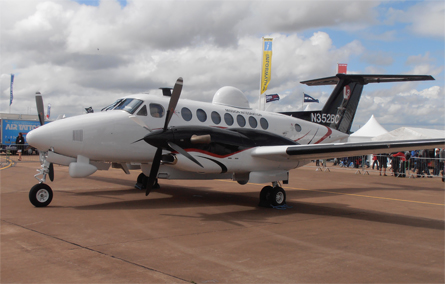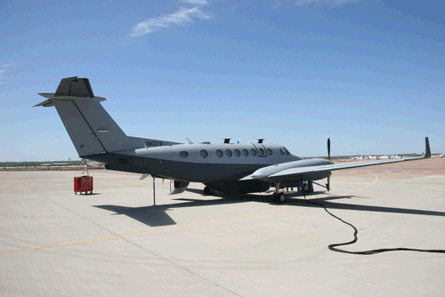In an unusual move, a major US defence contractor has launched a new product for the intelligence, surveillance and reconnaissance aircraft market at the Royal International Air Tattoo in the UK.
L-3 Communications’ Mission Integration Division (MID) has flown in a modified Hawker Beechcraft King Air 350ER, which can be equipped with multiple sensors and the company’s own processing, exploitation and dissemination system to support a perform a variety of military and civilian tasks.
Registered as N352BC, the King Air has an L-3 Wescam MX-15 electro-optical/infrared sensor payload mounted in a ball turret beneath its rear fuselage, and various airframe modifications. The latter include the addition of a large fairing to accommodate satellite communication equipment, several antennae, a line-of-sight tactical common data link and a self-protection suite.
 |
|---|
© Craig Hoyle/Flightglobal |
“The aircraft is the result of a research and development project by our company for the small ISR aircraft market,” said Bob Spivey, L-3 MID’s vice-president, special programmes. “This is a multi-year investment in multiple technologies.”
L-3 is promoting the system with a menu of sensor options, including signals intelligence equipment. Another potential addition currently being explored could lead to the integration of Selex Galileo’s PicoSAR lightweight synthetic aperture radar, Spivey said.
Following its appearance in the static display at RIAT the aircraft will be returned to the USA, where it will have a new, elongated nose section installed. To extend the King Air’s overall length by 0.6m (2ft), the new design will enable the company to add a second EO/IR ball turret at the front of the aircraft.
The King Air-based Spydr version should be deployed to the Dubai air show in November, with L-3 currently seeking the export licence approvals required to enable it to brief potential customers about the system’s capabilities. It is then expected to fly the aircraft back to the UK, where it will be involved in some unspecified trials activity.
Versions of the mission system and various payload options could be offered for carriage by larger platforms such as the Alenia Aeronautica C-27J Spartan or Lockheed Martin C-130, Spivey said, or scaled down for integration with unmanned air vehicles.
 |
|---|
© US Air Force |
Spydr builds on L-3’s experience in modifying 46 King Airs for the US armed military, including for the US Air Force’s Project Liberty acquisition (MC-12 pictured above), under which its first delivery was made within just over six months. “The results have been excellent,” Spivey said. “Now our thought is what’s next, and what could we do internationally.”
L-3 decided to give the Spydr its public debut at RIAT, due to it being attended by senior armed forces personnel and procurement officials from multiple nations from around the globe. “This is the perfect place to unveil it, as the world’s largest military air show,” said vice-president next-generation ISR special programmes Mark Johnson.
The company believes that it could eventually sell around 150 such aircraft, with several potential buyers already having been identified in Africa, Asia and the Middle East. Civilian roles could include forestry duties, maritime surveillance and fisheries protection, L-3 said.
Source: FlightGlobal.com























